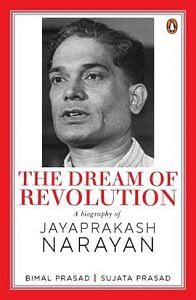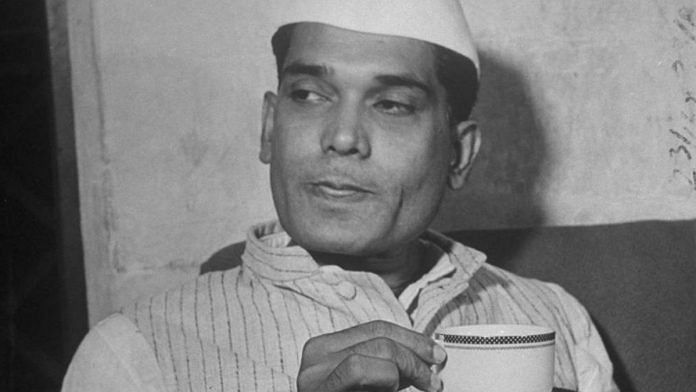Following the Chauri Chaura incident, the non-cooperation movement petered out. Many students who had walked out of government-controlled educational institutions returned to them, but not Jayaprakash. The Vidyapeeth could only provide education up to the intermediate level. Given his hardwired sense of what was right, he was conflicted about studying at a place that received grants from the government. For a few months, he lived and studied science at the residence of a family friend, Phuldeva Sahay, a professor of chemistry at the Banaras Hindu University (BHU). But he refused to join the university since it received grants from the government. It was around this time that he met Bhola Pant, a young Garhwali student seeking to study in America. Their friendship deepened, and eventually Jayaprakash was also attracted to the idea of studying there. A lecture delivered by Swami Satyadev Parivrajak on his experience of working his way through college in America was an added inspiration.
Jayaprakash’s decision was, however, a severely discomfiting one for his parents. His mother was especially distraught and he had to work hard to convince her. He received strong support from an unexpected quarter. His wife, Prabhavati, then only sixteen, recognized the potentially transformative aspect of her husband’s decision. She wrote to him saying that she was happy with his decision and hoped that on his return he would devote himself to the national cause. If there were any heartaches, questions and doubts, she kept them to herself.
At this point, Jayaprakash’s father was posted as ziladar in a place called Nasriganj in the Shahabad district. It is from there that Jayaprakash set out for Calcutta to begin his sea voyage to the United States aboard a small cargo liner, Janus, which began its journey to Kobe on 16 May 1922. From its second-class deck in the ambient daylight, attired in Western clothes hurriedly bought in Calcutta, Jayaprakash watched India’s vanishing coastline with some trepidation and hope. The expenses of travel up to Kobe were met partly by a grant from an educational foundation in Calcutta. His father paid the rest of the travel cost, in addition to giving him $600 to take care of contingent expenses.
Also read: Modi’s India has lost hope. It needs a JP for the 21st century
A viscerally intense experience, it was long-haul travel in a no-frills option. He had four travelling companions: one from Telangana, one from Hyderabad and two from Bengal. The sea was rough and at one point in the South China Sea, Janus found itself in the tail of a typhoon. Despite severe seasickness, Jayaprakash survived the ordeal and tried to make the most of brief halts at Rangoon, Penang, Singapore and Hong Kong. From Kobe, he went to Osaka, and then to the glistening seafront of Yokohama, from where he set sail for the United States after an interlude of several weeks spent travelling and proofreading for the Japanese national daily, the Mainichi. His German liner, Taiyo Maru, entered the San Francisco Bay on 8 October, three days before his twentieth birthday, after an eighteen-day voyage through vivid blue seas.
The campus of the University of California, Berkeley, a haven of calm with lush lawns and beautiful buildings, worked its serendipitous magic on Jayaprakash. He found temporary shelter in the attic of the Nalanda Club, a den of Indian students. The academic term had however already begun. Since he needed to wait until the following January, he thought it prudent to earn some money. While hunting for a job in Marysville, a neighbourhood town, he met Sikh activists from the Ghadar Party, headquartered in San Francisco. They persuaded him to stay back for a few days, eager to get details of the non-cooperation movement. On his third day in Marysville, he ran into Sher Khan, a Pathan overseer, externed from India. Khan directed him to a large orchard near Yuba City. A little off the beaten track, but somewhat idyllic, his job involved sun-drying large quantities of grapes to turn them into raisins. He worked there for about a month, at 40 cents an hour. Working nine hours per day—with half an hour’s break for lunch and Sundays off—Jayaprakash earned $21.60 per week.
Jayaprakash’s living space was scruffy and basic. It consisted of a long wooden shed without furniture but with a raised platform along the walls, covered with straw. The entire team of workers slept there, sharing an intimate space. It was old-fashioned community living with three dozen workers, mostly Pathans from the North-West Frontier Province. They liked the young man from India and crowded around him in the evenings for thought-provoking conversations about the freedom struggle. Out of regard for him, they stopped bringing beef into their common kitchenette. As no agricultural work was available near Marysville in winter, Jayaprakash returned to Berkeley to wash dishes and wait tables at restaurants. On Sundays, he moved around town, taking up whatever odd jobs were available.
Also read: The story of how RSS leaders deserted Jayaprakash and the resistance during Indira’s Emergency
In January, he was directly admitted into the second year, getting a year’s credit for his intermediate science degree. After completing his first term as a student of mathematics, chemical engineering and biology at Berkeley, Jayaprakash moved out again at the end of May, to work first as a grape picker at a scenic vineyard in the Sacramento Valley, and then as a packer and carton mender in a fruit and jam canning factory at San Jose. He enjoyed his time at Berkeley but had to leave when non-Californian citizens were forced to pay nearly double the fees, amounting to $300 a year. He was persuaded by his friend Bhola Pant, studying at the State University of Iowa, to migrate there. Iowa’s tuition fee of about $80 was far more affordable. So, after studying in California for two terms, Jayaprakash moved to the 1700- acre university campus at Iowa, a Midwestern US state positioned between the Missouri and Mississippi rivers. He shared Bhola’s room. The adjoining rooms too had Indian inmates. Jyoti Basu’s brother Kiran was one of them. They cooked their meals together and bonded over cups of coffee. In addition to his science curriculum, Jayaprakash studied French and German.
During the winter and summer breaks, the search for employment took Jayaprakash to Chicago, a city witnessing explosive growth. Several Indian students formed themselves into groups and rented shacks in the gritty slums of Chicago. They paid $10 per month, usually two persons to a room, sharing a weathered double bed. Rooms were not easy to get due to the colour prejudice and xenophobia. During weeks that hinged on uncertainty, Jayaprakash worked in a terracotta factory, a steel foundry with walls of jagged iron sheets, a butcher house (looking after refrigeration plants), in restaurants and departmental stores, once even as a vendor of a whitening cream in the narrow alleys inhabited by African Americans. By and large, coloured people were an anathema and had to strictly play by the rules. Very few people knew about India. He was once asked if he was from Honduras.
At Iowa, Jayaprakash did exceptionally well academically, getting straight A’s in all subjects except in drawing, which was a part of the course of chemical engineering that he was registered for, his only failure as a student. After spending about a year at Iowa, he felt the need for a more stimulating environment. At that time, the University of Wisconsin at Madison had in its faculty scholars known for their iconoclastic, progressive outlook. Wisconsin was also considered one of the most liberal states in the US—deriving its reputation from senators like Robert Follette, who pushed through a historic resolution demanding investigation into the most infamous scandal involving a presidential administration. Jayaprakash moved to Madison in the summer of 1924. He studied there for the next couple of years, while continuing to earn a living doing odd jobs like spring cleaning, clearing snow and washing dishes.
 This excerpt from ‘The Dream of Revolution: A Biography of Jayaprakash Narayan’ by Bimal Prasad and Sujata Prasad has been published with permission from Penguin Random House India.
This excerpt from ‘The Dream of Revolution: A Biography of Jayaprakash Narayan’ by Bimal Prasad and Sujata Prasad has been published with permission from Penguin Random House India.



